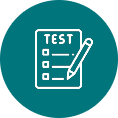Secondary School Programme - Scholastic
Steps done with heart, soul, mind & strength
Secondary School Programme - Scholastic
Steps done with heart, soul, mind & strength

The curriculum refers to the lessons and educational content to be taught to a learner in a school. In empirical terms, it may be regarded as the sum total of a planned set of educational experiences provided to a learner by a school. The curriculum provided by CBSE is based on National Curriculum Framework-2005 and seeks to provide opportunities for students to achieve excellence in learning.

OWS FOCUSES ON
The Secondary School (Classes IX – X) follows curriculum provided by CBSE based on National Curriculum Framework-2005 and seeks to provide opportunities for students to achieve excellence in learning.
The Curriculum strives to:
- Provide ample scope for holistic i.e. physical, intellectual and social development of students;
- Emphasize constructivist rather than rote learning by highlighting the importance of hands-on experience;
- Enlist general and specific teaching and assessment objectives to make learning competency-based;
- Encourage the application of knowledge and skills in real-life problem-solving scenarios;
- Uphold the ‘Constitutional Values’ by encouraging values-based learning activities;
- Promote Critical and Creative Thinking aligned to the 21st Century Skills in classrooms;
- Integrate innovations in pedagogy such as experiential learning, Sport & Art-Integrated Learning, toy-based pedagogy, storytelling, gamification etc. with technological innovations (ICT integration) to keep pace with the global trends in various disciplines;
- Promote inclusive practices as an overriding consideration in all educational activities;
- Enhance and support learning by different types of assessments; and
- Integrate environmental education in various disciplines from classes I- XII.
The Curriculum aims to:
- Achieve cognitive, affective and psychomotor excellence;
- Enhance self-awareness and explore innate potential;
- Attain mastery over laid down competencies;
- Imbibe 21st century learning, literacy and life skills;
- Promote goal setting, and lifelong learning;
- Inculcate values and foster cultural learning and international understanding in an interdependent society;
- Acquire the ability to utilize technology and information for the betterment of humankind;
- Strengthen knowledge and attitude related to livelihood skills;
- Develop the ability to appreciate art and show case talents;
- Promote physical fitness, health and well-being.
- Promote arts integrated learning.

CURRICULUM AREAS AT SECONDARY LEVEL
Secondary Curriculum envisions the all-around development of students in consonance with the holistic approach to education and therefore, has done away with artificial boundary between the co-curricular domain and the curricular domain. Secondary Curriculum provides students a broad and balanced understanding of subjects including languages, Mathematics, Science, and Social Science to enable students to communicate effectively, analyze information, make informed decisions, construct their worldview in alignment with constitutional values and move ahead in the direction of becoming productive citizens. The recent focus is on the development of 21st-century skills in settings where each student feels independent, safe, and comfortable with their learning. The Board hopes that schools will try to align curriculum in a way so that children feel more connected to it and employ their learning in real-life contexts. To achieve this aim, it is extremely important that children acquire adequate knowledge and skills in other core areas like Health and Physical Education, Life Skills, Values Education, Art Education, Work Education.
Therefore, for the purpose of fostering core competencies in learners, this curriculum encompasses major learning areas as under:
| Languages 1 | Compulsory |
| Languages 2 | |
| Social Science | |
| Mathematics | |
| Science | |
| Elective Subjects | Optional |
| Health and Physical Education | Compulsory Subjects having only school based internal assessment |
| Work Experience* | |
| Art Education |
* subsumed in Health and Physical Education
The curriculum envisages individual learning propensity and seeks to explore the potential of students in acquiring knowledge and skills. With greater orientation and research skills in core areas, students would evolve as judicious young adults with a sense of real self-estimate having true values and principles. The curricular areas are as follows:
(i) Languages include Hindi, English and 37 other languages. The curricula in languages focus on listening, speaking, reading and writing skills and, hence, develop effective communicative proficiencies. Learners use language to comprehend, acquire and communicate ideas in an effective manner.
(ii) Social Science (Geography, History, Economics and Political Science) intends to make learners understand their cultural, geographical and historical milieus and gain in-depth knowledge, attitude, skills and values necessary to bring about transformation for a better world. Social Science includes the learning of history and culture, geographical environment, global institutions, constitutional values and norms, politics, economy, interpersonal and societal interactions, civic responsibilities and the incorporation of the above-mentioned learning. Learners appreciate and value everyone’s right to feel respected and safe, and, also understand their Fundamental Rights and Duties and behave responsibly in the society.
(iii) Science: (Biology, Chemistry and Physics) includes gaining knowledge about Food, Materials, The World of the Living, how things work, Moving things, People and Ideas, Natural Phenomenon and Natural Resources. The Focus is on knowledge and skills to develop a scientific attitude and to use and apply such knowledge for improving the quality of life. The Curriculum promotes the ability to engage with science- related issues, and with the ideas of science, as a reflective citizen by being able to explain phenomena scientifically, evaluate and design scientific enquiry, and interpret data and evidence scientifically. Students understand the importance of to apply scientific knowledge in the context of real-life situations and gain competencies that enable them to participate effectively and productively in life.
(iv) Mathematics includes acquiring the concepts related to number sense, operation sense, computation, measurement, geometry, probability and statistics, the skill to calculate and organize, the ability to apply this Knowledge and acquired skills in their daily life and the skills to think mathematically. It also includes understanding of the principles of reasoning and problem solving. Children learn to rationalize and reason about pre-defined arrangements, norms and relationships in order to comprehend, decode, validate and develop relevant patterns.
(v) Skills Electives– A well-skilled workforce is one of the key requirements for the prosperity and growth for any country. Some skills come from general education, but specific occupational skills are also important. Typically, initial vocational education and training systems have a big part to play in supplying these skills. To develop skills and talents as a form of free expression, Board offers variety of competency-based subjects under NSQF like Retail, Information Technology, Marketing & Sales, Banking, Finance, AI etc. Choosing any one Skill subject at secondary level can helps the child to pursue what truly interests or pleases him or her. This liberty promotes a sense of self-esteem in accepting one’s own talents and strengths.
The curriculum and the study material for the Skill Electives is available on the CBSE academic website under the tab ‘Skill Education’ and can be accessed through the link: http://cbseacademic.nic.in/skill- education. html.
(vi) Art Education entails instruction in various art forms (visual as well as performing) with an aim to help children develop an interest for arts and encourage them to enthusiastically participate in related activities, thus, promoting abilities such as imagination, creativity, valuing arts and cultural heritage. In addition, Arts should be integrated with other subjects to promote creative thinking and expression
(vii) Health and Physical Education focuses on holistic development, both mental and physical, understanding the importance of physical fitness, health, wellbeing and the factors that contribute to them. Focus of this area is on helping children develop a positive attitude and commitment to lifelong, healthy active living and the capacity to live satisfying, productive lives with the help of health management, indigenous sports, Yoga, NCC, self-defense, fitness and life style choices.
(viii) Work Experience: The Work Experience has been subsumed in the Health and Physical Education, however, it is an integral part of the curriculum and is given as much as focus as Health and Physical Education.

SCHEME OF STUDIES
Subjects to be offered:
Class IX and X is a composite course. Students need to take only those subjects in class IX which they intend to continue in Class-X. Subjects can be offered as under:
| Subjects | Names of the subjects | Group | |
|---|---|---|---|
| Compulsory | Subject 1 | Language I (Hindi -Course A or Hindi -Course B or English Language and Literature) | Group-L |
| Subject 2 | Language II (Any one from the Group of Languages (Group-L) other than the Language chosen as Subject 1) | Group-L | |
| Subject 3 | Mathematics – Basic or Mathematics Standard | Group- A1 | |
| Subject 4 | Science | ||
| Subject 5 | Social Science | ||
| Optional | Subject 6 | Skill subject | Group-S |
| Subject 7 | Language III /Any subject other than opted above | Group- L/Group- A2 | |
| Subjects of | Subject 8 and 9 | Art Education | |
| Internal Assessment | Assessment and certification at school level | Health & Physical Education Work Experience* | |

STRUCTURE OF ASSESSMENT SCHEME
The Assessment scheme will have an 80 marks component for Board examination (class X) and Annual Examination (class IX) in all subjects except compulsory subjects to be assessed internally along with a 20 marks component of Internal Assessment. Students have to secure 33 percent in total in each of these components.
This condition has been relaxed vide Notification No. CBSE/Coord/DS/EC dated 11/10/2018 available at:
https://www.cbse.gov.in/cbsenew/Examination_Circular/2018/15_CIRCULAR.pdf
As the Board is progressively allowing more space to ‘learning outcome based’ assessment in place of textbook driven assessment, question papers of Board examinations will have more questions based on real-life situations requiring students to apply, analyze, evaluate and synthesize information as per the stipulated outcomes. The core- competencies to be assessed in all questions, however, will be from the prescribed syllabus and textbooks recommended therein. This will eliminate predictability and rote learning to a large extent.
For Class IX:
The assessment scheme will be similar to class X Board examination. However, the grading in class IX will be as follows:
| Grading Scale for Scholastic Areas (Class-IX) (School will award grades as per the following grading scale) | |
| MARKS RANGE | GRADE |
|---|---|
| 91-100 | A1 |
| 81-90 | A2 |
| 71-80 | B1 |
| 61-70 | B2 |
| 51-60 | C1 |
| 41-50 | C2 |
| 33-40 | D |
| 32 and below | *Essential Repeat |
Absolute grading in class IX is used keeping in view the number of students appearing from any particular school as against positional grading used for class X.
Internal Assessment (20 Marks): One-time year-end examination is complimented and supplemented with Internal Assessment (IA) that assesses students in diverse manner, at different times and also examines a broad range of curriculum objectives. IA, in effect school-based assessment, plays the dual role of providing a complete picture of students’ abilities or progress towards fulfilling the aims of education and informing teachers of students’ progress and therefore supporting classroom learning. It also informs the individual learner about his/ her progress over a period of time enabling them to develop strategies to improve learning.
Periodic Assessment (05 Marks)
The main purpose of Periodic Assessment is to assess the learning progress of students. Such Assessment done at regular intervals provides feedback and insight to teachers regarding learners’ needs and helps them to improve instruction, do remedial teaching and set curricular targets for a student or a group of students.
Periodic Tests (05 marks): As earlier, these would be restricted to 3 in each subject in a year and the average of best 2 would to be taken for final submission of marks. These tests tend to follow a pattern, which is quite similar to the final end of course examination, and have a gradually increasing portion of content. Hence, they also tend to prepare students for final summative exams in a more confident manner.
Multiple Assessment (05 marks):
Multiple assessment strategies relevant to particular learning outcomes are advised over the period of curriculum transaction. The subject teachers would determine the type and frequency of these. This would make assessment more comprehensive and provide schools/teachers flexibility to use multiple and diverse techniques to assess learners viz. observation, oral tests, individual or group work, class discussion, field-work, concept maps, graphic organizers, visual representation etc. Hence, the schools are given autonomy to use alternate modes of assessment as per the demand of the subject and the context towards addressing the goal of assessment for and as learning, such as, quizzes, project-work, Self and peer assessment, collaborative projects, experiments, classroom demonstrations, etc.
Portfolio (05 marks):
The creation of portfolios is suggested to broaden the scope of learning and achieve diverse curriculum outcomes by examining a range of evidence of student performances being assessed.
Subject Enrichment Activities (05 marks)
Subject enrichment activities aligned with the secondary school curriculum aim at enrichment of the understanding and skill development. They provide in-depth learning that motivates students to dig deeper into the discipline. These enrichment activities need to challenge students and permit them to apply knowledge to the next level. These activities become an important instrument to learn the processes by which knowledge is generated in a particular discipline. They ought to provide opportunity to students to explore their own interests as well along with an understanding of the nature of particular discipline.
| Area | Product | Process |
| Health and Physical Education including Work Experience | Overall fitness | Participation, team- spirit, commitment and honest effort. |
| Art Education | Expression, creativity and Aesthetic appeal | Participation, Creative process, material use, appreciation, reflection, effort, craftsmanship and completion |
| Grade | Connotation |
| A | Exemplary |
| B | Proficient |
| C | Developing |
| D | Emerging |
| E | Beginner |
Distribution of Periods/ Grades for Internal Assessment in Health and Physical Education (with Work Experience subsumed in it)
| Strand | Grades* |
|
1.GAMES Athletics/ Team Games Adventure Sports |
While filling online data, following grades may be filled against HPE: Class IX-X: Grade (A-E) on 5-point scale (A, B, C, D, E) |
| 2. Health and Fitness | |
| 3. SEWA |
Grades of SEWA is considered against Work Experience Class IX-X: Grade (A-E) on 5-point scale (A, B, C, D, E) |
| 4. Health and Activity Card |

